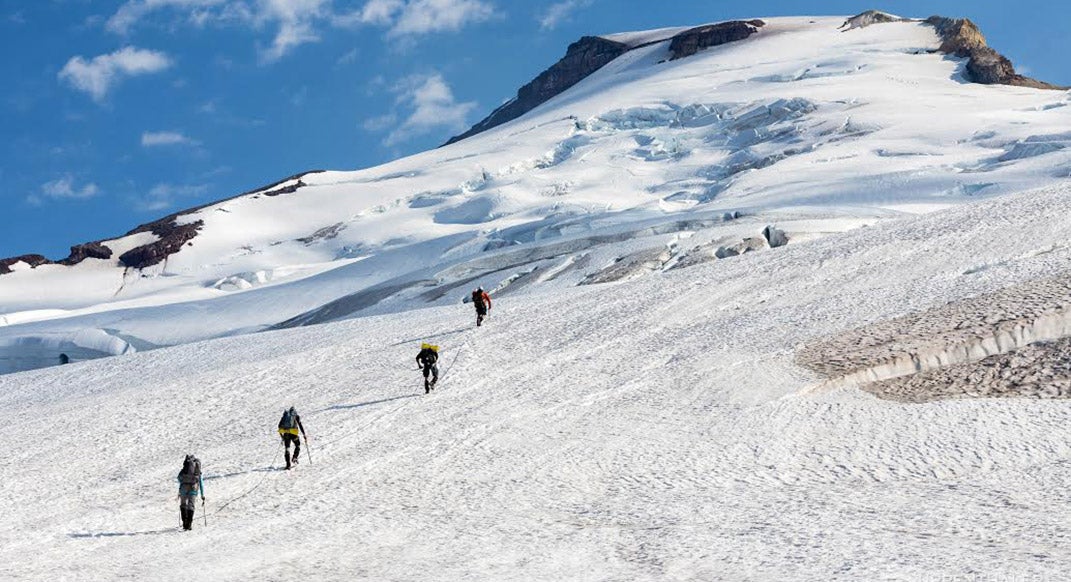Crazy Mount Baker Marathon Returns After Century-Long Hiatus

The Bellingham Mount Baker Trail wends 60 miles from the town of Bellingham, Washington, to the base of Mount Baker’s Deming Glacier. Those with the proper gear and experience (or a guide) can then climb eight miles to the summit of the volcano at 10,781 feet.
At least, that’s the plan.
As of August 2016, Washington-based nonprofit Cascade Mountain Runners has earned approval from thecity of Bellingham and Whatcom County, to begin construction on a continuous multi-use trail from the Washington coast to the state’s third-highest point.
The effort, which has been in the making since 2013, is inspired by one of the country’s original mountain ultras, the Mount Baker Marathon, which took place for three years from 1911-1913.
In September 2014, Trail Runner published the story of Cascade Mountain Runners founder Dan Probst and his mission to resurrect the Mount Baker Marathon, a 100-mile race from Bellingham to the summit of Mount Baker and back to town. At the time the article was published, Probst was till trying to gain approval (and figure out how) to host a race. The notion of a permanent trail was but a distant hope.
However, last year Probst gained approval to begin construction on the trail and to host a race (on an alternative route, beginning in the town of Concrete). On June 4th, runners will toe the line of the first modern Mount Baker Marathon. Around the same time, volunteers will put shovel to ground, beginning the multi-year process of building the Bellingham Mount Baker Trail.
“It’s public land all the way back [from Bellingham to Mt. Baker],” says Probst. Management of that land is split between “the city, county, state and Forest Service. You can see why it’s taken four years.”
The trail
The Bellingham Mount Baker Trail will be modeled after one of two main routes that were used in the original Mount Baker Marathon from 1911-1913.
In the original race, participants either drove or took a train from Bellingham to a trailhead, and then ran the remaining miles to the summit via two different trails. One of those was turned into what is now the Mount Baker ski area. The other, called the Ridley Creek Trail, still exists—at least in part.
“The first 10 miles were logged,” says Probst. And the remaining three miles had been “forgotten, abandoned. The Forest Service had stopped maintaining them. We’ve worked with the Forest Service to rebuild that portion.”
The first 25 miles, from Bellingham to the head of the Ridley Creek Trail, will be a new route, designed to stay as close to possible to the original course while staying entirely on trail.
Probst estimates the trail will take eight years to complete. “That’s optimistic,” he says. “Volunteer resources and money is what will move us forward.”
Among locals, there is a great deal of support for the trail, which will be open to bikers, hikers, runners and equestrians. “This is a trail for everyone,” Probst says. “The idea is that once the trail is completed, someone can fly into Bellingham, pick up supplies and follow the trail all the way to Baker.” A series of huts (or campgrounds) means that visitors will be able to backpack or fastpack the route.
It turns out people outside of Bellingham are getting excited about the trail, too. The board of the Pacific Northwest Trail—a 1200-mile trail connecting the Olympic Peninsula to Glacier National Park—is considering re-routing to make use of the Bellingham Mount Baker Trail. The Pacific Northwest Trail is a designated National Scenic Trail, so if the re-route took place, the new Bellingham Mount Baker Trail would automatically become a National Scenic Trail, too.
The modern race
The first-ever modern-day Mount Baker Marathon will take place on June 4, 2017. It won’t, however, be taking place on the same route that Probst and his friends have been scoping for the last few years.
The ultimate course all came down to a two-mile stretch of trail that crosses through the Mount Baker Wilderness—actually part of the original trail left over from the early days of the race. Policy prohibits competitive events from taking place on designated wilderness, unless specially permitted by Congress (races like the Western States 100 are possible through this kind of special approval).
Instead, the race will start and end in the town of Concrete, and its high point will be Sherman Peak, a sub-summit of Mount Baker (Grant Peak, Baker’s main summit, is designated wilderness, while Sherman Peak is within National Recreation Area boundaries).
The route up to Sherman Peak is runnable, but covered by large active glaciers, so safety is major concern. To mitigate the need for rope teams or self-arrest skills, race organizers will set 1.5 miles of fixed rope, all the way up the glacier to the summit.
“One rope costs $6,000,” says Probst. “The startup cost is huge. We’ll need 75 runners just to break even.” On top of supplies, Probst has hired the American Alpine Institute to write up a safety plan for the glacier portion of the race. Five AAI guides will work with volunteers to manage the fixed-rope lines and oversee an aid station on the side of the glacier.
Entry costs $595, but, as Probst points out, that’s “cheaper than if you were to hire a guide to climb Baker on your own.”